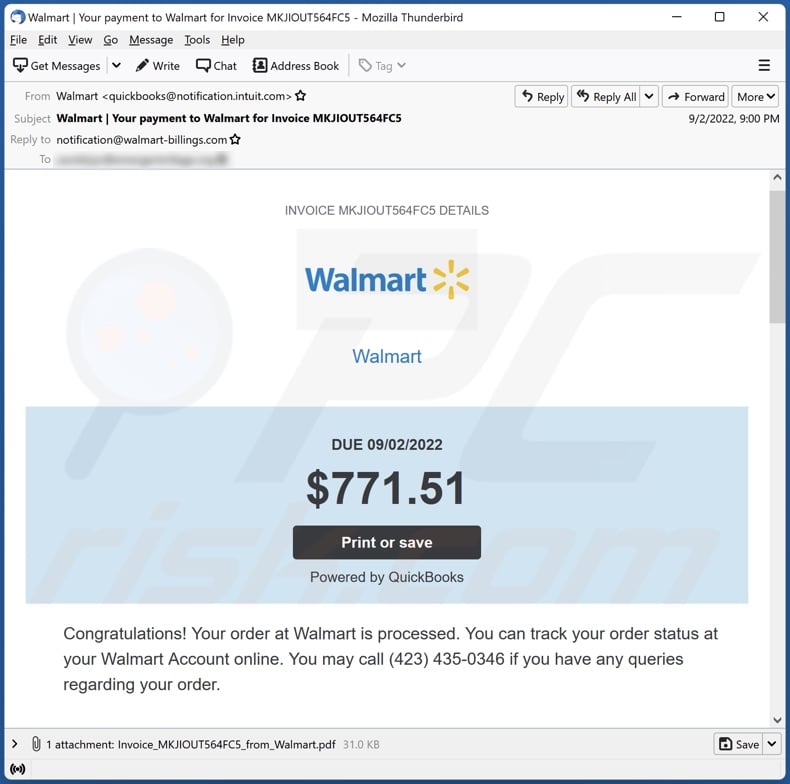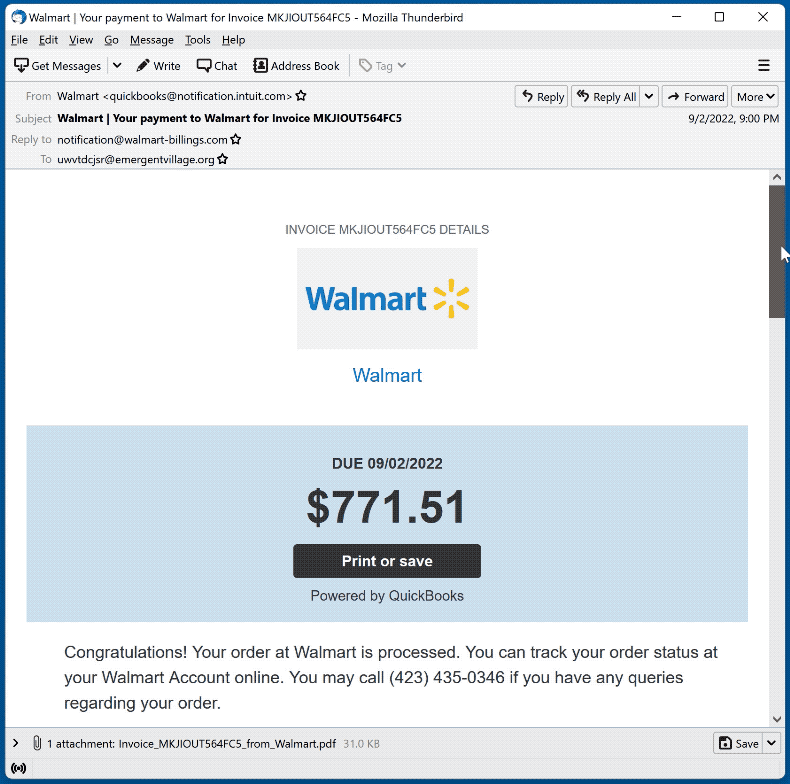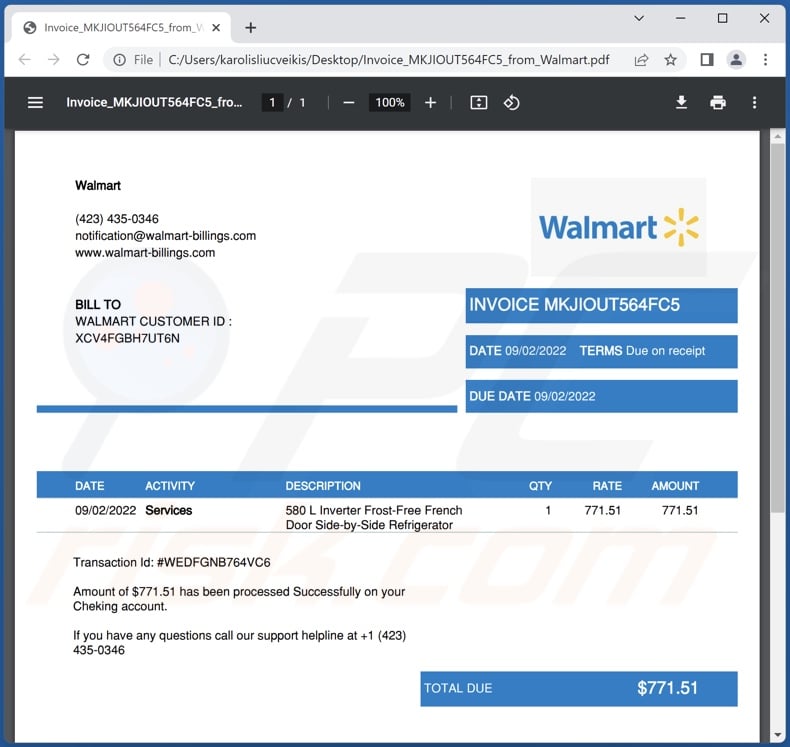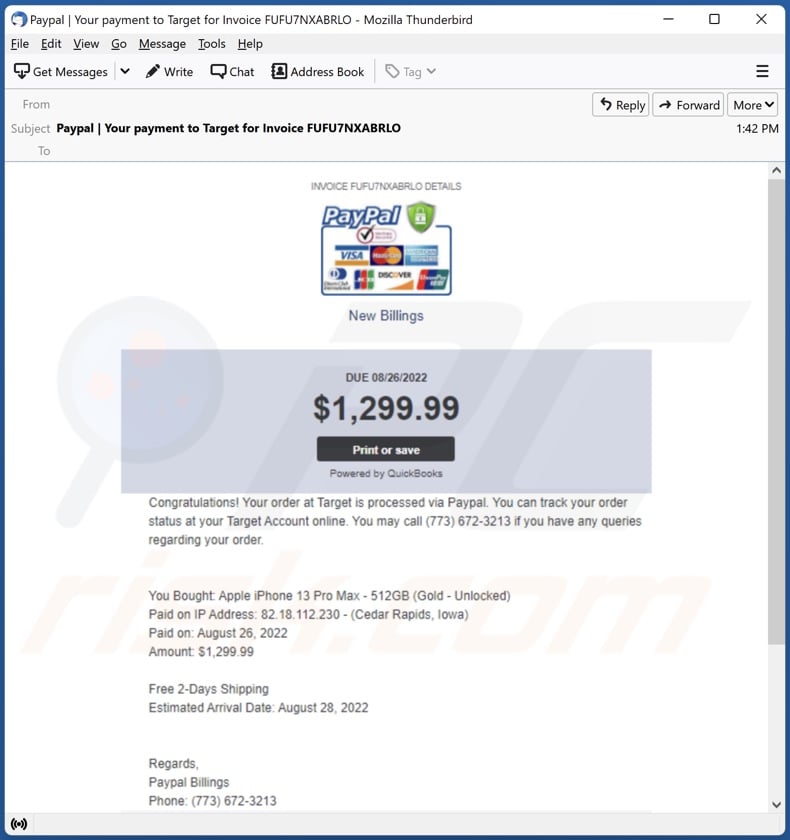Avoid getting scammed by fake "Your Order Is Processed" emails
Phishing/ScamAlso Known As: "Your Order Is Processed" spam email
Get free scan and check if your device is infected.
Remove it nowTo use full-featured product, you have to purchase a license for Combo Cleaner. Seven days free trial available. Combo Cleaner is owned and operated by RCS LT, the parent company of PCRisk.com.
What is the "Your Order Is Processed" email scam?
After analyzing two "Your Order Is Processed" emails, we determined that they are spam. These letters make similar claims about the recipient having purchased an expensive item from a well-known retailer. The goal is to trick the recipient into calling the provided telephone number to cancel the purchase - and thus be lured into an elaborate scam.
Note that there can be other variants of this spam mail, aside from the two we have inspected. It must be emphasized that the "Your Order Is Processed" emails are fake and that the legitimate entities mentioned in them (e.g., Walmart, Target, PayPal, etc.) are not associated with the scam.

"Your Order Is Processed" email scam overview
The emails with the subjects "Walmart | Your payment to Walmart for Invoice MKJIOUT564FC5" and "Paypal | Your payment to Target for Invoice FUFU7NXABRLO" (may vary) inform victims that their payment has been processed.
The supposedly purchased item(s) are expensive - such as smartphones, refrigerators, etc. This is a conscious decision on the scammers' part, as a costly purchase is unlikely to be forgotten, and the threat of losing a large sum of money would likely alarm the recipients.
These spam emails appear relatively legitimate; one of the researched letters even had a fake invoice attached to it. None of the security vendors at VirusTotal detected this file as malicious. Hence, it is possible that its inclusion in the email was intended to add another layer to the impression of legitimacy.
The "Your Order Is Processed" emails contain telephone numbers, which recipients are to call if they have any questions regarding the bogus order. As mentioned in the introduction, this mail is fake, and by telephoning the "support lines" - users will fall into the scammers' trap.
It is most likely that this scheme will operate as a refund scam. This model requires the victim to allow the cyber criminals (pretending to be customer service, billing department workers, technicians, etc.) to remotely access their device.
Once connected, the scammer usually requests the recipient to sign into their online bank account. Some remote access software allows the connecting party to darken the screen of the device that's being accessed; by using this feature, the cyber criminals can operate without the victim seeing their activities.
The scammers can edit the bank account website's HTML to display a different number or move the funds within (e.g., from checking to savings) - thereby creating the impression that the payment had already been withdrawn from the account. Note that neither of these actions removes the funds.
The victim is then asked to enter the refund amount themselves - while the screen is darkened. In the meantime, the criminals create the appearance (by manipulating HTML or moving funds within the accounts) that a significantly larger sum was refunded. The cyber criminals request that the nonexistent excess be returned (this is often accompanied by pleading and sob stories about the scammer "losing their job" if the mistake is not fixed).
Since the entire refund process is fake, no sum was ever charged or returned. Therefore, by returning the "excess money" - victims are essentially sending their own funds to the scammers. The "return process" typically involves difficult/impossible to trace methods, such as cash hidden in innocent-looking packages and shipped, cryptocurrencies, gift cards, pre-paid vouchers, or similar.
However, it is possible that the "Your Order Is Processed" email scam works by using a different model. For example, it could be a phishing scam that instructs victims to disclose personally identifiable or finance-related data over the phone or by entering it into a fake site. Phishing webpages are designed to record the data provided to them, and they are typically disguised as the log-in pages of online banks, emails, e-commerce sites, etc.
It is pertinent to mention that successfully scammed victims are often targeted repeatedly. By trusting an email like "Your Order Is Processed" - users can experience system infections, data loss, severe privacy issues, financial losses, and even identity theft.
If you have already disclosed log-in credentials to scammers - change the passwords of all potentially compromised accounts and inform their official support without delay. And if you've provided other private information (e.g., ID card details, credit card numbers, etc.) - immediately contact the appropriate authorities.
If you have allowed scammers to remotely access your device, you must first disconnect it from the Internet. Afterward, uninstall the remote access software the cyber criminals used (e.g., TeamViewer, UltraViewer, AnyDesk, etc.), as they may not need your permission to reconnect. Lastly, use an anti-virus to perform a full system scan and remove all the threats present.
| Name | "Your Order Is Processed" spam email |
| Threat Type | Phishing, Scam, Social Engineering, Fraud |
| Fake Claim | Recipient has made an expensive purchase; for any queries regarding it - the provided telephone number must be called. |
| Disguise | Walmart, Target, PayPal, etc. |
| Support Scammer Phone Number(s) | (423) 435-0346, (773) 672-3213 |
| Symptoms | Unauthorized online purchases, changed online account passwords, identity theft, illegal access of the computer. |
| Distribution methods | Deceptive emails, rogue online pop-up ads, search engine poisoning techniques, misspelled domains. |
| Damage | Loss of sensitive private information, monetary loss, identity theft. |
| Malware Removal (Windows) |
To eliminate possible malware infections, scan your computer with legitimate antivirus software. Our security researchers recommend using Combo Cleaner. Download Combo CleanerTo use full-featured product, you have to purchase a license for Combo Cleaner. 7 days free trial available. Combo Cleaner is owned and operated by RCS LT, the parent company of PCRisk.com. |
Spam campaign examples
We have analyzed thousands of spam emails; "Norton LifeLock email scam" is one that operates similarly to "Your Order Is Processed", and "You Have 3 Encrypted Documents", "2022 FIFA Lottery Award", "Due Payment-Invoice", "Norton - Your Computer Could Be At Risk" - are some of our newest scam email finds.
This mail can wear a wide variety of disguises, ranging from fake invoices to likewise fraudulent email account issue notifications. In addition to various scams, spam letters are used to proliferate trojans, ransomware, and other malware. Due to the prevalence of this mail, we strongly recommend exercising caution with incoming emails and messages.
How do spam campaigns infect computers?
Spam emails can contain infectious files as attachments or download links. These files can be archives (ZIP, RAR, etc.), executables (.exe, .run, etc.), PDF and Microsoft Office documents, JavaScript, and so on.
When a virulent file is executed, run, or otherwise opened - the infection process is triggered. For example, Microsoft Office documents infect devices by executing malicious macro commands.
How to avoid installation of malware?
We advise against opening the attachments and links found in suspect/irrelevant emails and messages since that can result in a system infection. It is just as important to use post-2010 Microsoft Office versions as they have the "Protected View" mode that prevents automatic macro command execution.
Aside from spam mail, malware is also spread through dubious download sources, illegal activation tools ("cracks"), fake updates, and online scams. Therefore, we recommend downloading from official and verified channels. Additionally, all programs must be activated and updated using functions/tools provided by legitimate developers.
Another recommendation is to be vigilant when browsing since fraudulent and malicious content usually appears ordinary and harmless.
We must stress the importance of having a reputable anti-virus installed and kept up-to-date. This software must be used to run regular system scans and to remove detected threats. If you've already opened malicious attachments, we recommend running a scan with Combo Cleaner Antivirus for Windows to automatically eliminate infiltrated malware.
Appearance of a variant of the "Your Order Is Processed" spam email (GIF):

Text presented in this email letter variant:
Subject: Walmart | Your payment to Walmart for Invoice MKJIOUT564FC5
INVOICE MKJIOUT564FC5 DETAILS
WalmartDUE 09/02/2022
$771.51
Print or save
Powered by QuickBooks
Congratulations! Your order at Walmart is processed. You can track your order status at your Walmart Account online. You may call (423) 435-0346 if you have any queries regarding your order.
You Bought: Samsung 580 L Inverter Frost-Free French Door Side-by-Side Refrigerator (RF57A5032S9/TL, Refined Inox, Convertible)
Paid on IP Address: 67.42.242.176 - (Cedar Rapids, Iowa)
Paid on: September 02, 2022
Amount: $771.51
Free 2-Days Shipping
Estimated Arrival Date: September 4, 2022
Regards,
Walmart Customer Service
Phone: (423) 435-0346
Bill to
WALMART CUSTOMER ID : XCV4FGBH7UT6N
Terms
Due on receipt
09/02/2022
Services
$771.51
580 L Inverter Frost-Free French Door Side-by-Side Refrigerator
1 X $771.51
Balance due $771.51
Transaction Id: #WEDFGNB764VC6
Amount of $771.51 has been processed Successfully on your Cheking account.
If you have any questions call our support helpline at +1 (423) 435-0346
Print or save
Walmart
(423) 435-0346
notification@walmart-billings.com
www.walmart-billings.com
If you receive an email that seems fraudulent, please check with the business owner before paying.
© Intuit, Inc. All rights reserved.
Privacy | Security | Terms of Service
Screenshot of the attachment distributed by this variant of the "Your Order Is Processed" spam email:

Screenshot of another variant of the "Your Order Is Processed" spam email:

Instant automatic malware removal:
Manual threat removal might be a lengthy and complicated process that requires advanced IT skills. Combo Cleaner is a professional automatic malware removal tool that is recommended to get rid of malware. Download it by clicking the button below:
DOWNLOAD Combo CleanerBy downloading any software listed on this website you agree to our Privacy Policy and Terms of Use. To use full-featured product, you have to purchase a license for Combo Cleaner. 7 days free trial available. Combo Cleaner is owned and operated by RCS LT, the parent company of PCRisk.com.
Quick menu:
- What is "Your Order Is Processed" spam email?
- Types of malicious emails.
- How to spot a malicious email?
- What to do if you fell for an email scam?
Types of malicious emails:
![]() Phishing Emails
Phishing Emails
Most commonly, cybercriminals use deceptive emails to trick Internet users into giving away their sensitive private information, for example, login information for various online services, email accounts, or online banking information.
Such attacks are called phishing. In a phishing attack, cybercriminals usually send an email message with some popular service logo (for example, Microsoft, DHL, Amazon, Netflix), create urgency (wrong shipping address, expired password, etc.), and place a link which they hope their potential victims will click on.
After clicking the link presented in such email message, victims are redirected to a fake website that looks identical or extremely similar to the original one. Victims are then asked to enter their password, credit card details, or some other information that gets stolen by cybercriminals.
![]() Emails with Malicious Attachments
Emails with Malicious Attachments
Another popular attack vector is email spam with malicious attachments that infect users' computers with malware. Malicious attachments usually carry trojans that are capable of stealing passwords, banking information, and other sensitive information.
In such attacks, cybercriminals' main goal is to trick their potential victims into opening an infected email attachment. To achieve this goal, email messages usually talk about recently received invoices, faxes, or voice messages.
If a potential victim falls for the lure and opens the attachment, their computers get infected, and cybercriminals can collect a lot of sensitive information.
While it's a more complicated method to steal personal information (spam filters and antivirus programs usually detect such attempts), if successful, cybercriminals can get a much wider array of data and can collect information for a long period of time.
![]() Sextortion Emails
Sextortion Emails
This is a type of phishing. In this case, users receive an email claiming that a cybercriminal could access the webcam of the potential victim and has a video recording of one's masturbation.
To get rid of the video, victims are asked to pay a ransom (usually using Bitcoin or another cryptocurrency). Nevertheless, all of these claims are false - users who receive such emails should ignore and delete them.
How to spot a malicious email?
While cyber criminals try to make their lure emails look trustworthy, here are some things that you should look for when trying to spot a phishing email:
- Check the sender's ("from") email address: Hover your mouse over the "from" address and check if it's legitimate. For example, if you received an email from Microsoft, be sure to check if the email address is @microsoft.com and not something suspicious like @m1crosoft.com, @microsfot.com, @account-security-noreply.com, etc.
- Check for generic greetings: If the greeting in the email is "Dear user", "Dear @youremail.com", "Dear valued customer", this should raise suspiciousness. Most commonly, companies call you by your name. Lack of this information could signal a phishing attempt.
- Check the links in the email: Hover your mouse over the link presented in the email, if the link that appears seems suspicious, don't click it. For example, if you received an email from Microsoft and the link in the email shows that it will go to firebasestorage.googleapis.com/v0... you shouldn't trust it. It's best not to click any links in the emails but to visit the company website that sent you the email in the first place.
- Don't blindly trust email attachments: Most commonly, legitimate companies will ask you to log in to their website and to view any documents there; if you received an email with an attachment, it's a good idea to scan it with an antivirus application. Infected email attachments are a common attack vector used by cybercriminals.
To minimise the risk of opening phishing and malicious emails we recommend using Combo Cleaner Antivirus for Windows.
Example of a spam email:

What to do if you fell for an email scam?
- If you clicked on a link in a phishing email and entered your password - be sure to change your password as soon as possible. Usually, cybercriminals collect stolen credentials and then sell them to other groups that use them for malicious purposes. If you change your password in a timely manner, there's a chance that criminals won't have enough time to do any damage.
- If you entered your credit card information - contact your bank as soon as possible and explain the situation. There's a good chance that you will need to cancel your compromised credit card and get a new one.
- If you see any signs of identity theft - you should immediately contact the Federal Trade Commission. This institution will collect information about your situation and create a personal recovery plan.
- If you opened a malicious attachment - your computer is probably infected, you should scan it with a reputable antivirus application. For this purpose, we recommend using Combo Cleaner Antivirus for Windows.
- Help other Internet users - report phishing emails to Anti-Phishing Working Group, FBI’s Internet Crime Complaint Center, National Fraud Information Center and U.S. Department of Justice.
Frequently Asked Questions (FAQ)
Why did I receive this email?
Cyber criminals distribute spam emails by the thousand with the hopes that at least some recipients will fall for their scams. This mail is not personal.
I have provided my personal information when tricked by this spam email, what should I do?
If the provided information were log-in credentials - immediately change the passwords of all potentially exposed accounts and inform their official support. And if the disclosed data was of a different personal nature (e.g., ID card details, credit card numbers, etc.) - contact the corresponding authorities without delay.
I have allowed cyber criminals to remotely access my computer, what should I do?
If you have allowed cyber criminals to access your device remotely, you must first disconnect it from the Internet. Secondly, remove the remote access software used by the criminals (e.g., TeamViewer, UltraViewer, AnyDesk, etc.). Lastly, run a complete system scan with an anti-virus and eliminate the detected threats.
I have read a spam email but didn't open the attachment, is my computer infected?
No, merely opening an email will not initiate any system infection processes. Malware download/installation is performed by malicious files distributed through this mail; hence, when the attachments or links found in spam emails are opened/clicked - the infection processes begin.
I have downloaded and opened a file attached to a spam email, is my computer infected?
Whether an infection occurred depends on the purpose of the file, and its format may also impact it. Infections can only be caused by files designed to do so. If the opened file was an executable (.exe, .run, etc.)- most likely, yes - your system was infected. However, malicious documents (.doc, .xls, .pdf, etc.) may require additional user interaction (e.g., enabling macro commands) to begin downloading/installing malware.
Will Combo Cleaner remove malware infections present in email attachments?
Yes, Combo Cleaner is capable of detecting and removing practically all known malware infections. It must be emphasized that running a full system scan is crucial - since sophisticated malicious software typically hides deep within systems.
Share:

Tomas Meskauskas
Expert security researcher, professional malware analyst
I am passionate about computer security and technology. I have an experience of over 10 years working in various companies related to computer technical issue solving and Internet security. I have been working as an author and editor for pcrisk.com since 2010. Follow me on Twitter and LinkedIn to stay informed about the latest online security threats.
PCrisk security portal is brought by a company RCS LT.
Joined forces of security researchers help educate computer users about the latest online security threats. More information about the company RCS LT.
Our malware removal guides are free. However, if you want to support us you can send us a donation.
DonatePCrisk security portal is brought by a company RCS LT.
Joined forces of security researchers help educate computer users about the latest online security threats. More information about the company RCS LT.
Our malware removal guides are free. However, if you want to support us you can send us a donation.
Donate
▼ Show Discussion